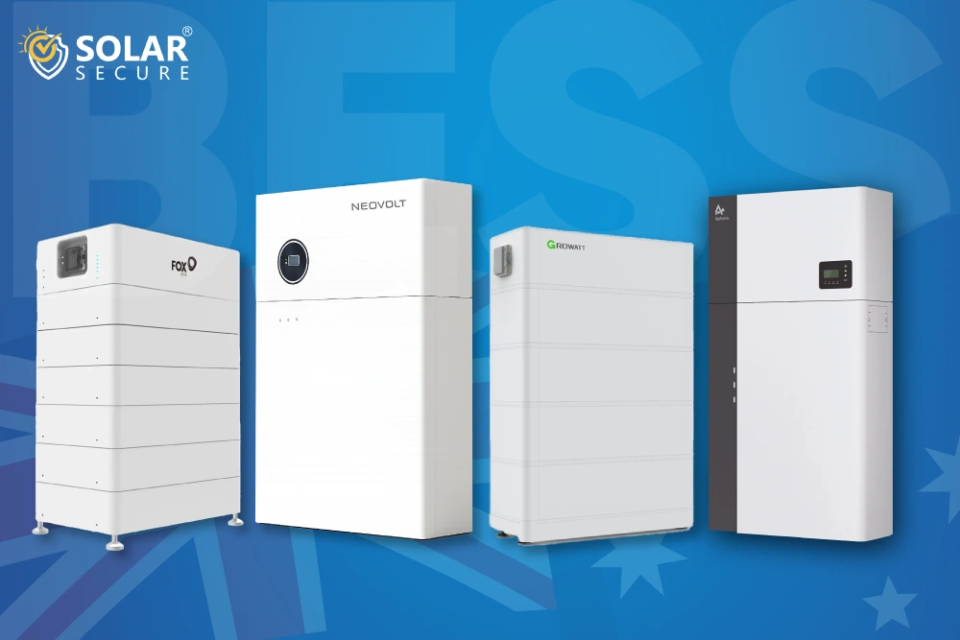Battery energy storage systems (BESS) are using renewable energy to power more homes and businesses than ever before. If installed incorrectly or not safely commissioned, they pose serious safety risks. A BESS must be installed by a properly licenced electrician.
What are battery energy storage systems?
Battery energy storage systems (BESS) are the technologies we simply know as batteries that are big enough to power your business. Power from renewables, like solar and wind, are stored in a BESS for later use. They come in different shapes and sizes, suit different applications and settings, and use different technologies and chemicals to do their job.
They play an important role in green energy supplies and make renewable energy more reliable. Sometimes they are connected to the main power grid to supply unused or excess power for others.
There are three main types of BESS:
- a pre-packaged battery module (enclosed factory-connected batteries)
- a pre-packaged system (enclosed factory-connected batteries with other components, such as a charger control or inverter)
- a custom-made battery bank (individual batteries installed with other components and interconnected).
Components of BESS
Battery Cells: The primary storage units in a BESS.
Battery Management System (BMS): Monitors and controls the battery cells.
Fire Suppression Systems: Prevent and control fires within the BESS.
Cooling Systems: Manage the temperature of the battery cells to prevent overheating.
What are the risks of battery energy storage systems?
They are a serious safety risk if not correctly installed or commissioned. They can cause:
Electric shock
Battery cells can deliver a severe electrical shock when interconnected as battery banks, reaching hazardous voltage levels. There will also be 240-volt rated parts or other components on the energy regulators and inverters that have hazardous voltages.
Fire and explosion
Most lead-acid batteries generate hydrogen and oxygen gases when charging and so need good ventilation to avoid an explosion or fire. Other battery types may also emit gases and need good ventilation.
Lithium-ion batteries do not produce any exhaust gases during normal operation, but they can produce flammable gases if there is a fault.
Fire and explosions can also result from excessive temperatures (either under normal operating conditions or due to an overload), component failure, short circuit or loose connections.
Flash burns
A battery has sufficient energy to cause an arc flash if it short circuits, or if a fault occurs. An arc flash can have temperatures above 12,000°C, capable of melting metal or causing fires and explosions, and cause arc flash injuries. Generally, higher battery energy storage capacities have a higher risk of arc flash.
Exposure to hazardous chemicals
Battery casings can degrade or be damaged from a variety of impacts. They can also rupture because of excessive temperatures generated from a change in chemical reaction from over-charging. If a battery casing is ruptured, the fluid or gel (electrolyte) inside can leak, resulting in toxic fumes, burns, corrosion or explosions.
How do I manage the risks?
Installers licence and accreditation
Contractors installing Solar PV Systems, including BESS’s require:
- Clean Energy Council accreditation; and
- A valid electrical contractor’s licence.
Only use contractors who have both accreditation and a valid licence to install your solar PV system and/or the BESS.
You can check a contractor’s accreditation on the Clean Energy Council Website, and the contractor’s licence on the Electrical Workers and Contractors Licensing Board Website.
Installation location
While it is tempting to install the BESS an out of sight location in your home or business, the installation location plays an important part in how safe your BESS is, and restrictions apply on where a BESS can be installed.
Before installation begins, read the BESS installation manual to know where and how your BESS can be installed. There are different battery types currently on the market with some batteries requiring wall mounting and some only floor mounted, some can only be installed indoors or outdoors.
Don’t just rely on your contractor to do the right thing, educate yourself so you know the location chosen is suitable before installation begins.
Restricted rooms in the home
For homeowners, a BESS cannot be installed in a room which you or your family uses for normal living activities (also known habitable room). These rooms include:
- Bedroom
- Living room
- Lounge room
- Kitchen
- Dining room
- Study
- Family room
Other restricted locations in the home and workplace
Other locations a BESS cannot be installed in include:
- In ceiling spaces or wall cavities.
- Under stairs ways, access walkways and floors of habitable rooms.
- On top of roofs.
- In areas with a switchboard or generation system and
- In an evacuation or escape route.
BESS clearance zone
Your contractor is required to install your BESS with a clearance zone for safety reasons. The zone extends 600mm either side and to the front of the BESS, and 900mm above.
Your contractor cannot install the BESS in the location selected, if one of the following is in the clearance zone:
- any exit of the building, including garage doors.
- windows, building ventilation or opening into a habitable room; and
- an electrical appliance not associated with the BESS, such as a washing machine, air-conditioning unit or hot water system.
Fire protection barrier
Your contractor cannot install the BESS on or against a wall or structure that has a habitable room on the other side without a fire protection barrier, if the wall or structure is made of combustible material such as cladding, timber or gyprock plasterboard etc.
A fire protection barrier is to prevent potential fires from the BESS, burning through a wall or structure and spreading into the habitable room. The barrier needs to be installed between the BESS and the wall or structure.
The barrier needs to be the same dimensions as the BESS clearance zone, 600mm either side and 900mm above the BESS, and made from material considered non-combustible in accordance with the Australian Standard. Walls or structures made from brick or masonry block, concrete, compressed cement sheeting or tiled with ceramic or terracotta tiles are not considered combustible and do not require a fire protection barrier.
Conclusion
Battery Energy Storage Systems (BESS) are transforming the way we store and manage renewable energy, but they also come with their own set of safety, operational, and financial risks. This blog explores the critical role of risk assessment in ensuring reliable, secure, and cost-effective BESS deployment.
From identifying potential hazards like fire risks, system failures, and cybersecurity threats to addressing environmental and regulatory compliance, risk assessment is essential for safeguarding both assets and people. Readers will learn why thorough evaluation before installation can reduce downtime, extend battery lifespan, improve return on investment, and build long-term resilience. Whether you’re a homeowner, business, or energy provider, understanding the importance of risk assessment can help you make smarter, safer decisions when adopting battery storage technology.





